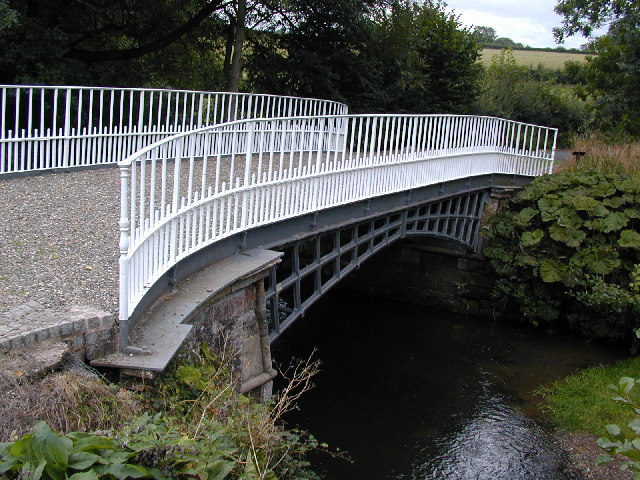|
Cantlop Bridge
Cantlop Bridge is a single span cast-iron road bridge over the Cound Brook, located to the north of Cantlop in the parish of Berrington, Shropshire. It was constructed in 1818 to a design possibly by Thomas Telford, having at least been approved by him, and replaced an unsuccessful cast iron coach bridge constructed in 1812. The design of the bridge was innovative for the period, using a light-weight design of cast-iron lattice ribs to support the road deck in a single span, and appears to be a scaled-down version of a Thomas Telford bridge at Meole Brace, Shropshire. The bridge is the only surviving Telford-approved cast-iron bridge in Shropshire, and is a Grade II* listed building and scheduled monument. It originally carried the turnpike road from Shrewsbury to Acton Burnell. History and description Thomas Telford worked as the county surveyor of Shropshire between 1787 to 1834, and the bridge is reported to have once held a cast iron plate above the centre of the arch inscri ... [...More Info...] [...Related Items...] OR: [Wikipedia] [Google] [Baidu] |
Cound Brook
Cound Brook (pronounced COOnd) is a tributary of the River Severn in Shropshire, England, running to south of the county town Shrewsbury. The Cound Brook rises in the Stretton Hills and discharges into the River Severn at Eyton on Severn after winding its way for across the southern Shropshire-Severn plains. The flow of the Cound Brook can vary from sluggish in a dry summer to a raging torrent in winter or spring. The river is crossed by several bridges along its route including two historic and unusual iron bridges. Several other roads cross the river as fords. The river has breached its banks on the lower flood plain several times in the past and is now monitored by the local rivers authority. The river is named after Cound, the last settlement it passes through prior to the confluence with the River Severn. Conversely one of the villages on its route, Condover, is thought to have been named after the river during the late medieval period. The Coundmoor Brook is a smaller ... [...More Info...] [...Related Items...] OR: [Wikipedia] [Google] [Baidu] |
Abutment
An abutment is the substructure at the ends of a bridge span or dam supporting its superstructure. Single-span bridges have abutments at each end which provide vertical and lateral support for the span, as well as acting as retaining walls to resist lateral movement of the earthen fill of the bridge approach. Multi-span bridges require piers to support ends of spans unsupported by abutments. Dam abutments are generally the sides of a valley or gorge, but may be artificial in order to support arch dams such as Kurobe Dam in Japan. The civil engineering term may also refer to the structure supporting one side of an arch An arch is a vertical curved structure that spans an elevated space and may or may not support the weight above it, or in case of a horizontal arch like an arch dam, the hydrostatic pressure against it. Arches may be synonymous with vau ..., or masonry used to resist the lateral forces of a vault.Pevsner, N. (1970) ''Cornwall''; 2nd ed. Harmo ... [...More Info...] [...Related Items...] OR: [Wikipedia] [Google] [Baidu] |
Structural Engineering
Structural engineering is a sub-discipline of civil engineering in which structural engineers are trained to design the 'bones and muscles' that create the form and shape of man-made structures. Structural engineers also must understand and calculate the stability, strength, rigidity and earthquake-susceptibility of built structures for buildings and nonbuilding structures. The structural designs are integrated with those of other designers such as architects and building services engineer and often supervise the construction of projects by contractors on site. They can also be involved in the design of machinery, medical equipment, and vehicles where structural integrity affects functioning and safety. See glossary of structural engineering. Structural engineering theory is based upon applied physical laws and empirical knowledge of the structural performance of different materials and geometries. Structural engineering design uses a number of relatively simple structu ... [...More Info...] [...Related Items...] OR: [Wikipedia] [Google] [Baidu] |
Bridges In Shropshire
A bridge is a structure built to span a physical obstacle (such as a body of water, valley, road, or rail) without blocking the way underneath. It is constructed for the purpose of providing passage over the obstacle, which is usually something that is otherwise difficult or impossible to cross. There are many different designs of bridges, each serving a particular purpose and applicable to different situations. Designs of bridges vary depending on factors such as the function of the bridge, the nature of the terrain where the bridge is constructed and anchored, and the material used to make it, and the funds available to build it. The earliest bridges were likely made with fallen trees and stepping stones. The Neolithic people built boardwalk bridges across marshland. The Arkadiko Bridge (dating from the 13th century BC, in the Peloponnese) is one of the oldest arch bridges still in existence and use. Etymology The '' Oxford English Dictionary'' traces the origin of ... [...More Info...] [...Related Items...] OR: [Wikipedia] [Google] [Baidu] |
Listed Buildings In Berrington, Shropshire
Berrington, Shropshire, Berrington is a civil parish in Shropshire, England. It contains 43 Listed building#England and Wales, listed buildings that are recorded in the National Heritage List for England. Of these, one is listed at Grade I, the highest of the three grades, two are at Grade II*, the middle grade, and the others are at Grade II, the lowest grade. The parish contains the villages of Berrington, Betton Strange, Cross Houses, and is otherwise rural. Most of the listed buildings are houses and associated structures, farmhouses and farm buildings, many of them dating from the 17th century or before, and basically timber framed. There are two listed churches, the older church All Saints Church, Berrington also having listed structures in the churchyard. In addition, the listed buildings include two bridges, a former hospital, a milestone and a milepost, a number of pumps, some with associated troughs, and a war memorial. __NOTOC__ Key Buildin ... [...More Info...] [...Related Items...] OR: [Wikipedia] [Google] [Baidu] |
Grade II* Listed Buildings In Shropshire Council (A–G)
There are over 20,000 Grade II* listed buildings in England. This article comprises a list of these buildings in the county of Shropshire Council. List See also * Grade I listed buildings in Shropshire References External links {{DEFAULTSORT:Shropshire Council (A-G) Lists of Grade II* listed buildings in Shropshire ... [...More Info...] [...Related Items...] OR: [Wikipedia] [Google] [Baidu] |
English Heritage
English Heritage (officially the English Heritage Trust) is a charity that manages over 400 historic monuments, buildings and places. These include prehistoric sites, medieval castles, Roman forts and country houses. The charity states that it uses these properties to "bring the story of England to life for over 10 million people each year". Within its portfolio are Stonehenge, Dover Castle, Tintagel Castle and the best preserved parts of Hadrian's Wall. English Heritage also manages the London Blue Plaque scheme, which links influential historical figures to particular buildings. When originally formed in 1983, English Heritage was the operating name of an executive non-departmental public body of the British Government, officially titled the Historic Buildings and Monuments Commission for England, that ran the national system of heritage protection and managed a range of historic properties. It was created to combine the roles of existing bodies that had emerged from a lo ... [...More Info...] [...Related Items...] OR: [Wikipedia] [Google] [Baidu] |
Ashlar
Ashlar () is finely dressed (cut, worked) stone, either an individual stone that has been worked until squared, or a structure built from such stones. Ashlar is the finest stone masonry unit, generally rectangular cuboid, mentioned by Vitruvius as opus isodomum, or less frequently trapezoidal. Precisely cut "on all faces adjacent to those of other stones", ashlar is capable of very thin joints between blocks, and the visible face of the stone may be quarry-faced or feature a variety of treatments: tooled, smoothly polished or rendered with another material for decorative effect. One such decorative treatment consists of small grooves achieved by the application of a metal comb. Generally used only on softer stone ashlar, this decoration is known as "mason's drag". Ashlar is in contrast to rubble masonry, which employs irregularly shaped stones, sometimes minimally worked or selected for similar size, or both. Ashlar is related but distinct from other stone masonry tha ... [...More Info...] [...Related Items...] OR: [Wikipedia] [Google] [Baidu] |
County Surveyor
A county surveyor is a public official in the United Kingdom and the United States. United Kingdom Webb & Webb describe the increasing chaos that began to prevail within this same period in field of county surveying in England and Wales, with county surveyors appointed by the justices of the peace at quarter sessions. Eventually, the military defence component of county surveying in the UK began to separate from the civil in 1791, with the Crown's 'Board of Ordnance' being commissioned to carry out a comprehensive survey of the South Coast of England which, as a result of 'the last invasion of Britain 1797', at Fishguard in South West Wales ultimately extended to all of the UK. With that shift in emphasis, county surveying began to concentrate more on its civil engineering and civic architecture roles, producing the historically famous British county surveyors such as Thomas Telford, John Loudon McAdam and John Nash; the expression, "county surveyor", became a UK statutory t ... [...More Info...] [...Related Items...] OR: [Wikipedia] [Google] [Baidu] |
Cantlop
Cantlop is a small village in the England, English county of Shropshire. It is part of the civil parish of Berrington, Shropshire, Berrington. Nearby villages include Condover, to the west of Cantlop, and the village of Berrington to the north-west, on the other side of the Cound Brook which flows to the north of Cantlop, and Pitchford to the south. The area is largely agricultural. The elevation at Cantlop Cross is above sea level. Etymology Various meanings have been suggested for the name, such as an enclosed or cut-off valleyBowcock, E. ''Shropshire place names'', Wilding & Son, 1923, p.61 or an enclosure in a waste or common land, common.Gelling and Foxall, ''The place-names of Shropshire, Volume 1'', English Place-Name Society, 1990, p.69 History To the north of the village there is a cast iron, cast-iron single-span bridge — the Cantlop Bridge — now generally accepted to have been designed by Thomas Telford, who was the County Surveyor of Shropshire.Cragg, R. ''Civi ... [...More Info...] [...Related Items...] OR: [Wikipedia] [Google] [Baidu] |
Acton Burnell
Acton Burnell is a village and parish in the English county of Shropshire. Home to Concord College, it is also famous for an early meeting of Parliament where the Statute merchant was passed in 1283. The population at the 2011 census was 544. The village today has a post office and Anglican parish church, as well as a Roman Catholic cemetery. History Running to the north-west of the village is a Roman road, that ran between the modern day settlements of Wroxeter and Leintwardine. The etymology of Acton Burnell is Old English ''āc'' (oak) and ''tūn'' (farm, estate), joined with the family name Burnell (thus meaning the part of Acton held by the Burnell family). It was the birthplace of Robert Burnell, a thirteenth century prelate, politician and regent under Edward I. For 20 years, as guests of Sir Edward Smythe a former pupil, the monks of Douai, following expulsion from France in the French Revolution, lived in community at Acton Burnell until they moved to Somerset ... [...More Info...] [...Related Items...] OR: [Wikipedia] [Google] [Baidu] |



.jpg)


